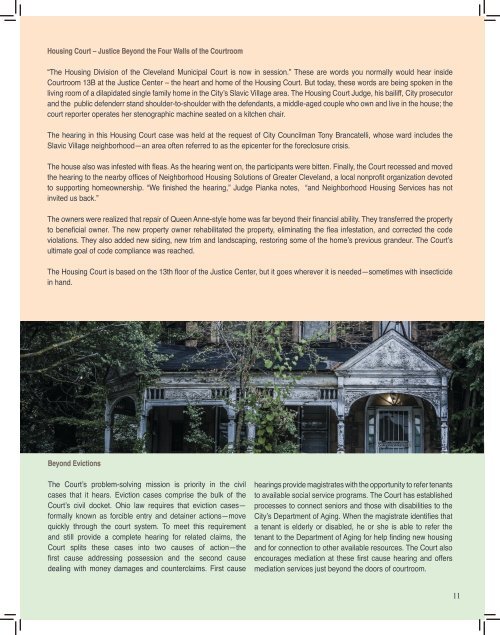publication for website
Create successful ePaper yourself
Turn your PDF publications into a flip-book with our unique Google optimized e-Paper software.
Housing Court – Justice Beyond the Four Walls of the Courtroom<br />
“The Housing Division of the Cleveland Municipal Court is now in session.” These are words you normally would hear inside<br />
Courtroom 13B at the Justice Center – the heart and home of the Housing Court. But today, these words are being spoken in the<br />
living room of a dilapidated single family home in the City’s Slavic Village area. The Housing Court Judge, his bailiff, City prosecutor<br />
and the public defenderr stand shoulder-to-shoulder with the defendants, a middle-aged couple who own and live in the house; the<br />
court reporter operates her stenographic machine seated on a kitchen chair.<br />
The hearing in this Housing Court case was held at the request of City Councilman Tony Brancatelli, whose ward includes the<br />
Slavic Village neighborhood—an area often referred to as the epicenter <strong>for</strong> the <strong>for</strong>eclosure crisis.<br />
invited us back.”<br />
violations. They also added new siding, new trim and landscaping, restoring some of the home’s previous grandeur. The Court’s<br />
ultimate goal of code compliance was reached.<br />
in hand.<br />
Beyond Evictions<br />
The Court’s problem-solving mission is priority in the civil<br />
cases that it hears. Eviction cases comprise the bulk of the<br />
Court’s civil docket. Ohio law requires that eviction cases—<br />
<strong>for</strong>mally known as <strong>for</strong>cible entry and detainer actions—move<br />
quickly through the court system. To meet this requirement<br />
and still provide a complete hearing <strong>for</strong> related claims, the<br />
Court splits these cases into two causes of action—the<br />
dealing with money damages and counterclaims. First cause<br />
hearings provide magistrates with the opportunity to refer tenants<br />
to available social service programs. The Court has established<br />
processes to connect seniors and those with disabilities to the<br />
a tenant is elderly or disabled, he or she is able to refer the<br />
and <strong>for</strong> connection to other available resources. The Court also<br />
mediation services just beyond the doors of courtroom.<br />
11



